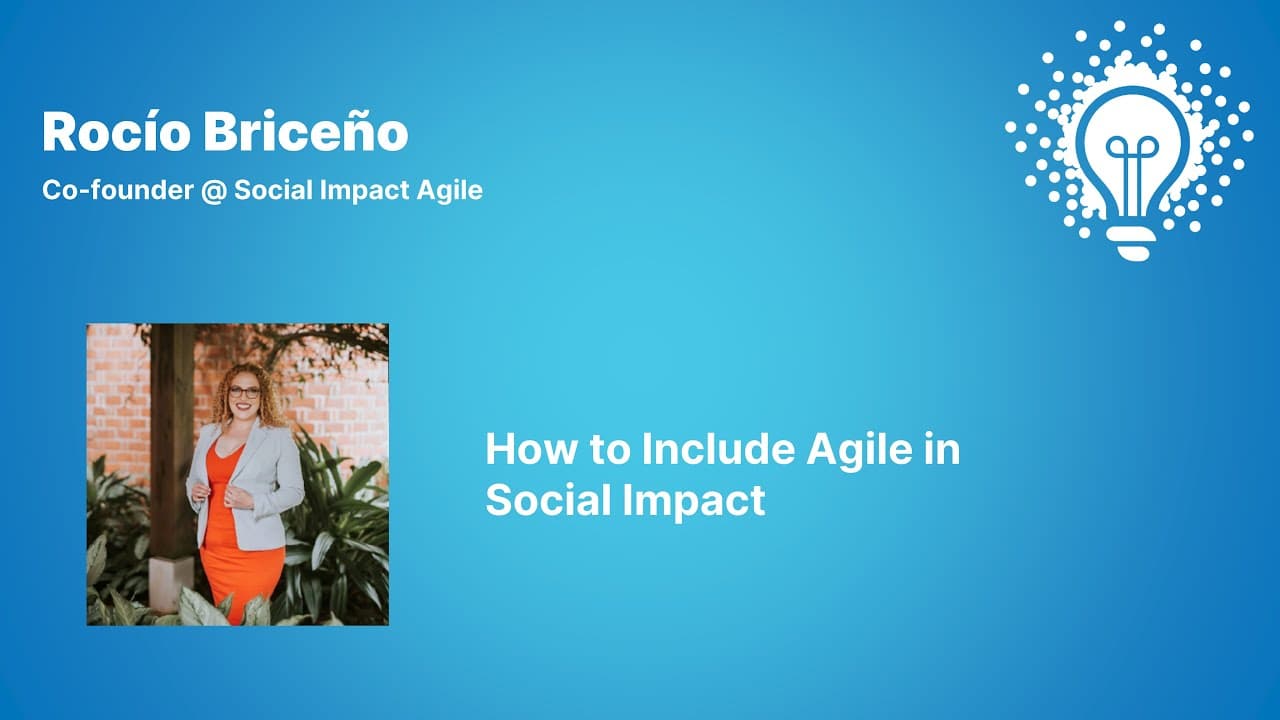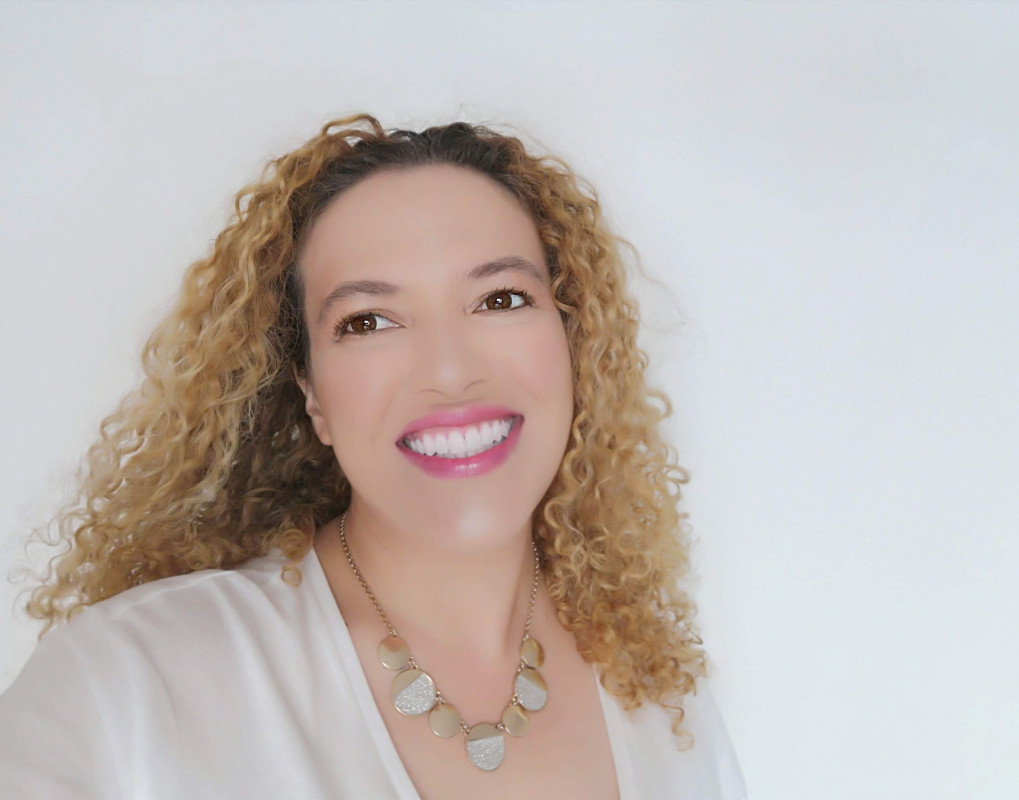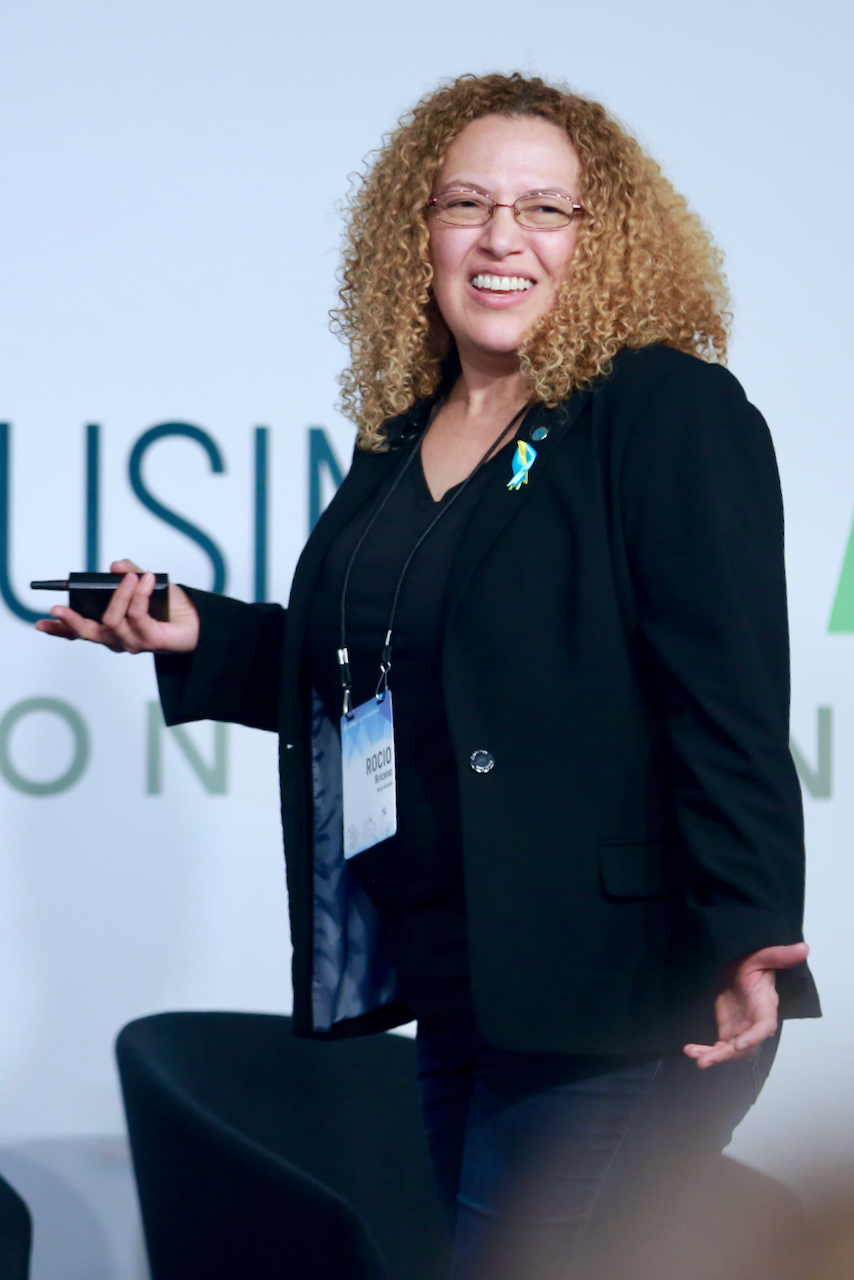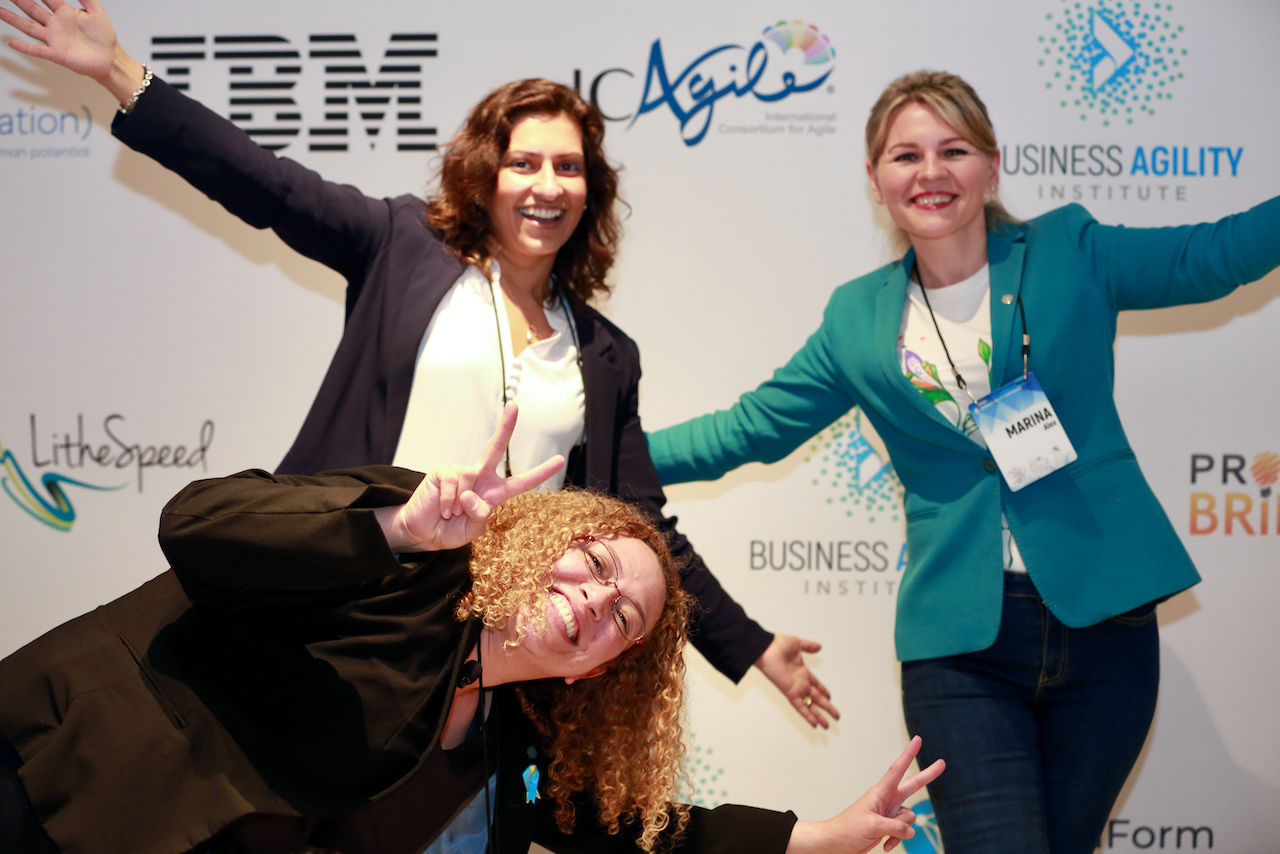My name is Rocío Briceño. I happen to be a computer engineer, administrator as well, that ended up in Harvard studying public leadership,and become Vice President candidate of my country by a phone call that I just receive.
That is part of the story. I am co-founder of something called, and I said something, because it's something. It's an organization, because when people get together to do something, that is an organization, but it is called Social Impact Agile, that actually is a movement that I created with Alistair Cockburn—of the writers of the manifesto.
When we said,"Why there is not too many successful efforts in social impact projects?" And I said, "It's because of you,I blame you." You attached the manifesto just to software. When you say software, scrum mastery, user stories. I blame as well Sutherland and the rest.
How come you want the other people that is not related to that to understand that? So he said, "Well, let's fix it." So we wrote a new manifesto. That is the Social Impact Agile Manifesto. After that, I created the movement and the organization that is Social Impact Agile.
So what we try to do? We try to create or make a difference. I know when you have love in your life, food in your plate, you are beautiful, you want to improve the world. That is the next logical thing to do, don't you? It happens to you too, because everybody here, I think, have those basic needs already solved.
So the next thing to do is to improve the world. So we want to make a difference. Of course, sometimes make a difference requires as well money. We gathered together, we're five of us, and we wrote this manifesto.
This is Alistair, Gerardo Blizter, myself, and two more people that they say mentioned my name, but we are out of the movement. We grow that and we say,let's see what happens. So far it's like self-organizing effort. We're still growing. There are people all around the world that normally send me an emailand they said, "I want to join that." And I said, "Well, welcome, what do you want to do?"
We have some objectives... Something is happening with the presentation that doesn't show the colors. We have five commitments, and that five commitments are referring to the commitments that has to have anyone in order to make a social project using agile. Clear and share objectives, beneficiaries that are actively involved, because sometimes development and social projects are just made by PhDover there, somewhere, thinking about people with a need, but they don't really feel that need. So you have to involve those teams with social passion. And transparency.
I will go to one story, where I use these commitments, where we have a really tough situation. I was working in the Inter-American Development Bank. I just got hired by them one day. They called me and they said,"There is a water shortage." And I was like, "Water shortage?" "Yeah, for the entire city." -"What city?" -"Tegucigalpa." Is one really amazing city in Central America. It's a really important city of Honduras. It's the capital of Honduras.
They happen to have problems with the water supply. First, like one day a week, later two days a week, at the end when we have this phone call from the president asking for help, they just have water, two days per week for the entire city, so this was a mess.
If you have been without water, you know what I am talking about, especially if you have kids or people that are sick in your house, or if you have pets. That gets terrible. There is no development, there is no business, there is no nothing if there is no water.
I was in the office that day, and they said there is a total city without water. They want to fix it using agile. And I was like, "Okay." You're expert in Agile, don't you? Yes. So what we say to the President? Okay, let's say that we will do it. I don't know how, but we will do it.
I get a bunch of people that are specialists in communications, because me as an engineer by profession, I know I need the help from the people that are professional in communication, because that is why they start their a career in order to become professional in that. When you are a leader, you have to be a good communicator.
But normally we start to doing the plan or the analysis, or the research and stuff,and throw theories, and we forget about the basics. And the basic is communicate with the people, and get the stakeholders involved. So when I talk to the communicators, They said, "Well, we have to go there. That is pretty logical." So they went over there, they went to the Honduras.
They realized that the population has a lot of construction, you can see in the picture. But the government didn't have the infrastructure for the water ready in order to afford the structures that were building. And the business were coming and, like, money talks, so they buy the things.They buy sometimes the permissions. But there is no water. The most important thing that these communicators told me is that most of the people just didn't care.
I was like, "How come you don't care that you have water?" No, they have their own tanks that is filled once a week or something, but they think they will have water later on, because they have money, and they don't care about the others that don't have water.
This lack of awareness about what other people need was making this huge mess in the city. I was like, "Okay, I know agile." I can do design thinking. I can apply scrum, I can apply scrum at scale. I could apply Heart of Agile. I could apply, I don't know—mention what." But how we can make the people to care about the other ones, to care about their neighbor.
Then I collect another specialist, because we need a sociologist. So the sociologist came. The specialist in water came. The government and the multilateral organization, the bank, gave us the money and empowerment.
So money was not a problem. Empowerment was not a problem. We have the blessing from the president, but you have to do a difference, you have to solve the situation. I realized by myself will be impossible, so I started a call about 50 agile coaches in Latin America and I received the 50 ones that were able to go with me to Tegucigalpa in order to make a boot camp.
We reserved a whole hotel. We put 400 people over there from several sectors: private, public, education, construction, infrastructure, people from the poorest sector, people with money, with the richest sector of the city. I was making a combination with these 50 agile coaches, and I said, "if you are here... -What is your name? -Eric. That I can say, Eric, you are here, you are in this conference, that means that you know about this topic. You have interest about this topic. I can bet that you are really good in what you say. So come with me, and let's do a difference. We need to put water in Tegucigalpa." So that was the challenge.
They were doing their best, these 50 agile coaches, in order to use all the techniques, in order to understand these people. But as well, the most important part is making them aware that they have to care about each other, and they have to care about politics, and they have to care about respect the rules. Because if they continue breaking the rules, they will continue making a mess with the water.
So at the end, because I don't want to make you worried about this story, we use design thinking, Heart Of Agile, the scrum, scrum at the scale. We were using value-stream mapping, we were using retrospective, we were using powerful question techniques.
During the three days that we were having the boot camp. We use cards on the wall. And we ended up with 10 possible projects to solve this situation. Already with the money to finance that, and with the commitment to the several sectors in order to work on that.
So we improved the situation Tegucigalpa is not like the place without any shortage of water, but it's better than when we make the intervention. I have to say that was successful. It wasn't successful because of the method, was successful because of the commitment, and because of the 50 agile coaches, that wanted to make a change as well with their neighbors. With Tegucigalpa.We used the clear and shared objectives, beneficiaries that were already involved, the teams with social passion, the transparency, and the frequent and visible results.
Okay, after that you can say, "Okay, what is next?" Can you do that in a city? But can you do an entire agile country? And one day I was visiting my mom, because I live in Washington, DC. Sorry, I am not really good at using this. Can we go to the other one? To the last one? It's the last one before me, he broke it. Okay, let's see... That one? No. I am not going to touch it. One more...That one. Thank you, I did it.
So I was just visiting my mom in Costa Rica, and I have to go to do somewhere around at the bank. Normal things that you do over there. I mean, make a line, really boring line. No one can get fun when you are making a line for them and for errands. And suddenly I received a phone call. I was checking all these WhatsApp messages, somebody were asking about my phone number and I was like, "Who's looking for me?"
Suddenly I received a phone call.
-Hello?Hello?Rocío?
-Yes?
-You are in Costa Rica?
-Yes, I am visiting my mom. Who are you?
-Well, you don't know me.
-Well, I know that.
-We are talking to you from the Liberal Progressive's Party.
-Oh no, I don't have money. I cannot bring you anything.
-We know that the next year will be like the elections.
-I already told you that I don't have money.
-No, I am not reaching you about that.
-So, why you are reaching me? I am making a line for the bank, so please go to the point, because I don't have time to lose with the politics. I am not a politician.
So he told me,
-"well I have heard about you and the things that you have been doing in agile in other countries."
-And I was, "Yes?"
-So we want to create an agile country and this phone call is to tell you to stay in Costa Rica, don't go back to the USA, and run as candidate for Vice President for the country.
-I was like, "There is a camera here?"
But actually that happened so I was like, "Can I have some minutes to finish my errand at the bank?" I will go back to my house, and I remember that I just sent a text message to my mom telling they want me to become vice President of the country. What do you think?
She said, "Weren't you at the bank?" Yes. And later on calling my husband— who is American— I was like, "Honey, they want me to run as Vice President candidate of the country. To make an agile country." And he said, "Babe, is it not a scam?"
So I met this guy and I ended up quitting my job. Being almost pretty much all the year without a job, living from my savings in order to create the journey to how to make agile323 governmental institutions. Applying some kind of lean, as well deciding what people is going to be involved in this effort, and trying to do the same thing that we did with the water, but for entire government plan.
Suddenly to happen that we lost the elections. Two or three weeks ago, because it was on February 6th. We won the 11% of the congressM positions with an agile proposal. So that is the story. We use five commitments. These are the key points that we use in the government plan. And pretty much that's it.






